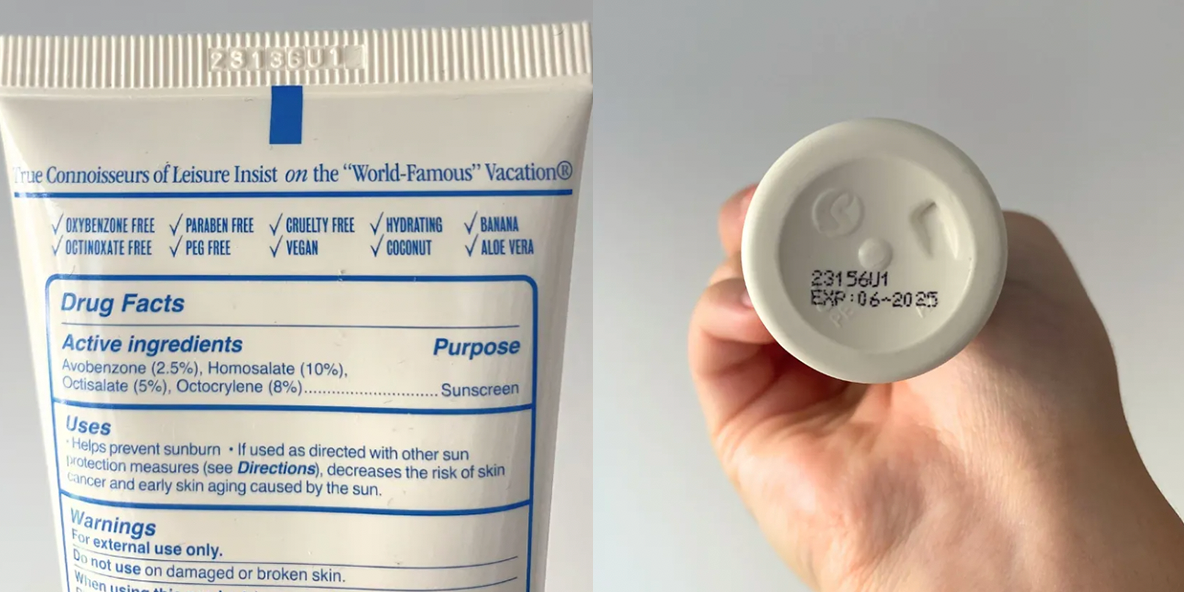Expiration Sunscreen

Expired sunscreen may not provide adequate protection. Check the expiration date before using it.
Expiration Sunscreen protecting your skin from the harmful effects of the sun is essential for maintaining healthy skin. Sunscreen is a vital tool in this defense, but it’s important to ensure that the product you’re using is still effective. Understanding the expiration date of sunscreen and the potential risks of using expired sunscreen is crucial for proper skin care.
We will explore the significance of expiration dates on sunscreen, the potential consequences of using expired sunscreen, and how to properly store and use sunscreen to maximize its effectiveness. By the end, you’ll have a clear understanding of the importance of checking sunscreen expiration dates and the impact it can have on your skin’s protection.
The Importance Of Sunscreen
Protecting Skin From Uv Damage
Wearing sunscreen shields skin from harmful UV rays.
- Prevents sunburn and skin damage
- Reduces premature aging signs
Reducing Risks Of Skin Cancer
Regular sunscreen use helps lower skin cancer risks.
- Protects against UVA and UVB rays
- Decreases chances of melanoma

Understanding Sunscreen Expiration
Understanding sunscreen expiration is crucial for effective sun protection. Sunscreen is essential in protecting our skin from the harmful effects of the sun’s ultraviolet (UV) rays. However, like most things, sunscreen has an expiration date, and using expired sunscreen may not provide adequate protection from the sun’s rays. In this section, we will explore how sunscreen loses effectiveness and how to identify the expiration date.
How Sunscreen Loses Effectiveness
Sunscreen loses effectiveness over time due to various factors, including exposure to high temperatures, sunlight, and oxygen. When exposed to high temperatures, the ingredients in sunscreen break down, making the sunscreen less effective. Similarly, prolonged exposure to sunlight and oxygen can cause the active ingredients in sunscreen to degrade, reducing the sunscreen’s effectiveness. Additionally, if the sunscreen is not stored correctly, it can also lose its effectiveness.
Identifying The Expiration Date
Identifying the expiration date of your sunscreen is essential to ensure that you are adequately protected from the sun’s harmful rays. Most sunscreens have an expiration date printed on the bottle or packaging. The expiration date may be represented as an expiry date or a period after opening (PAO) symbol, which indicates how long the product will remain effective after opening. The PAO symbol is a picture of an open jar with a number followed by the letter “M” inside it, indicating the number of months the product will remain effective after opening.
It is essential to check the expiration date before using sunscreen and to dispose of any expired sunscreen. Using expired sunscreen may not provide adequate protection from the sun’s harmful rays, leading to sunburn, skin damage, and an increased risk of skin cancer.
Expired Sunscreen Risks
Using expired sunscreen poses risks as it may lose effectiveness, leading to sunburns and skin damage. Check the expiry date before application to ensure proper protection against harmful UV rays.
Inadequate Uv Protection
Expired sunscreen provides reduced protection against harmful UV rays, increasing risk of sunburn and skin damage.
Potential Skin Irritation
Using expired sunscreen can lead to skin irritation, rashes, and allergic reactions due to deterioration of active ingredients.
Proper Sunscreen Storage Tips
Avoiding Heat And Sunlight
Store sunscreen in a cool, dry place away from direct sunlight. Excessive heat can cause the ingredients in sunscreen to degrade, reducing its effectiveness. Avoid leaving it in hot cars or near radiators.
Seal And Store Correctly
Ensure the sunscreen bottle is tightly sealed to prevent contamination or spoilage. Store it upright to maintain the integrity of the formula and to avoid potential leakage.
Recognizing Expired Sunscreen
It’s important to recognize expired sunscreen to ensure effective protection. Check the expiration date on the packaging and look for any changes in texture, color, or smell. Expired sunscreen may not provide adequate protection against harmful UV rays. Always replace sunscreen that has passed its expiration date to safeguard your skin.
Recognizing Expired Sunscreen Changes in Color and Consistency When inspecting sunscreen for expiration, observe any changes in its color and consistency. Expired sunscreen may appear discolored, with a noticeable change in its texture. Unusual Odor and Separation Expired sunscreen may emit an unusual odor and exhibit signs of separation. If the product appears to be separating into layers or has an unpleasant smell, it is likely expired. Expired sunscreen can be recognized through changes in color and consistency. Additionally, it may exhibit an unusual odor and signs of separation. When inspecting sunscreen, observe any changes in color and consistency. If the product appears to be separating into layers or has an unpleasant smell, it is likely expired.

Safe Sunscreen Disposal
Proper disposal of expired sunscreen is crucial to protect the environment and prevent harm to wildlife. Follow these guidelines for safe sunscreen disposal.
Environmentally Friendly Methods
- Recycle empty sunscreen containers when possible.
- Reuse bottles for other purposes like storing small items.
- Research biodegradable sunscreen options for eco-friendly disposal.
Local Disposal Regulations
- Check local regulations for proper sunscreen disposal guidelines.
- Dispose of sunscreen according to your area’s specific rules.
- Contact local waste management for guidance on safe disposal methods.
Alternatives To Expired Sunscreen
Using expired sunscreen can be dangerous and ineffective, leaving you vulnerable to harmful UV rays. But what can you do if you find yourself without a fresh bottle of sunscreen on a sunny day? Fortunately, there are alternatives to expired sunscreen that can provide you with the protection you need.
Physical Sun Barriers
Physical sun barriers, such as hats, sunglasses, and clothing, can provide an effective alternative to expired sunscreen. These barriers work by blocking the sun’s rays from reaching your skin, reducing the risk of sun damage and skin cancer. When choosing clothing for sun protection, look for materials with a tight weave and dark colors, as these provide the best protection.
New Sunscreen Innovations
If you don’t have access to physical sun barriers, there are new sunscreen innovations that can provide you with an alternative to expired sunscreen. One example is mineral-based sunscreens, which use zinc oxide or titanium dioxide to reflect the sun’s rays. These sunscreens are less likely to irritate the skin and are effective for a longer period of time than traditional sunscreens.
Another option is tinted sunscreens, which provide both sun protection and coverage. These sunscreens come in a variety of shades and can be used as a daily foundation or as a base for makeup.
| Pros | Cons |
|---|---|
| Physical sun barriers provide effective sun protection without the need for sunscreen. | May not be suitable for all activities, such as swimming. |
| New sunscreen innovations offer alternative sun protection options. | May be more expensive than traditional sunscreens. |
| Tinted sunscreens can provide both sun protection and coverage. | May not be suitable for all skin types. |
Overall, it’s important to remember that using expired sunscreen is not worth the risk. By using physical sun barriers or new sunscreen innovations, you can protect your skin from harmful UV rays without relying on expired sunscreen.

Educating Others About Sunscreen Safety
Educating others about sunscreen safety includes emphasizing the importance of checking expiration dates on sunscreen products. Using expired sunscreen can lead to reduced effectiveness and compromised protection against harmful UV rays. Stay informed to ensure you’re adequately shielded from sun damage.
Creating Awareness In Communities
Organizing workshops and events on sunscreen safety.
Sun Safety Programs And Campaigns
Implementing educational campaigns in schools and local organizations.
When it comes to sunscreen safety, it is crucial to spread awareness and educate individuals about the importance of protecting their skin from harmful UV rays.
One effective way to promote sunscreen safety is by creating awareness in communities.
By organizing workshops and events, individuals can learn about the significance of sunscreen usage and proper application techniques.
Moreover, implementing sun safety programs and campaigns can help reach a wider audience and emphasize the necessity of sun protection.
Through educational initiatives in schools and local organizations, individuals can gain valuable knowledge about the dangers of sun exposure and the role of sunscreen in preventing skin damage.
Frequently Asked Questions
How Long Can You Use After The Expiration Date?
It’s not recommended to use products after their expiration date. Expiry dates indicate the last day for optimal quality and safety.
How To Tell If Sunscreen Is Out Of Date?
Check the expiration date on the sunscreen packaging. Look for changes in color or consistency. An expired sunscreen may not provide adequate protection.
Does Sunscreen Expire Fda?
Yes, sunscreen does expire as per FDA guidelines. Check the expiration date on the packaging before use.
Is Expired Sunscreen Ok To Use?
Expired sunscreen may be less effective. Check for changes in smell, texture, or color before using.
Conclusion
In the quest for healthy skin, using expired sunscreen can do more harm than good. It’s crucial to check the expiration date before applying. Protect your skin by disposing of old sunscreen and investing in new, quality products. Your skin will thank you for it.







